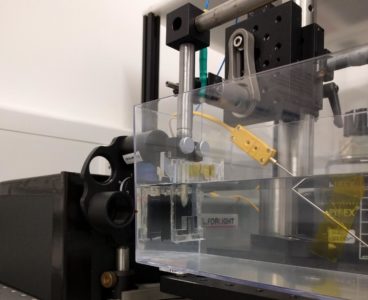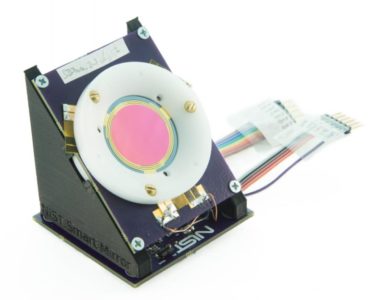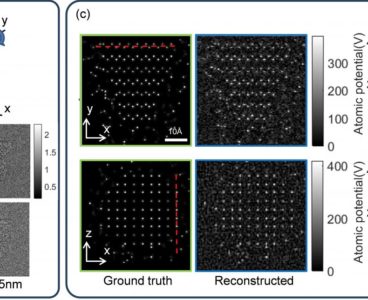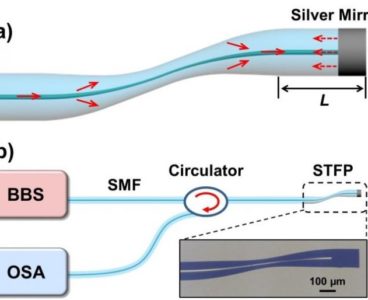
New Plastic Films Deflect or Trap Heat With Zero Energy Required
Environmentally Stable Laser Emits Remarkably Pure Light
Researchers have developed a compact laser that emits light with extreme spectral purity that doesn’t change in response to environmental conditions. The new potentially portable laser could benefit a host of scientific applications, improve clocks for global positioning (GPS) systems, advance the detection of gravitational waves in space and be useful for quantum computing. Researchers…
Lasers Send Audible Messages to Specific People
Researchers have demonstrated that a laser can transmit an audible message to a person without any type of receiver equipment. The ability to send highly targeted audio signals over the air could be used to communicate across noisy rooms or warn individuals of a dangerous situation such as an active shooter. In The Optical Society…
Tiny Light-guiding Structures Improve Biomedical Devices, Wearables
For the first time, researchers have fabricated light-guiding structures known as waveguides just over one micron wide in a clear silicone commonly used for biomedical applications. The tiny, flexible waveguides can be used to make light-based devices such as biomedical sensors and endoscopes that are smaller and more complex than currently possible. “To the best…
Faster 3D Imaging Could Aid Diagnosis of Cardiovascular, Gastrointestinal Disease
Sensing Method Enhances Greenhouse Gas Analysis
An international team of researchers has used an unconventional imaging technique known as ghost imaging to make spectroscopic measurements of a gas molecule. The new approach by scientists at Tampere University of Technology in Finland, the University of Eastern Finland and the University of Burgundy Franche-Comté in France, works over a wide range of wavelengths…
New Technique Could Aid the Visually Impaired
Researchers have developed a fundamentally new approach to a see-through display for augmented reality, or smart glasses. By projecting images from the glass directly onto the eye, the new design could one day make it possible for a user to see information such as directions or restaurant ratings while wearing a device almost indistinguishable from…
Fiber Optic Sensor Measures Tiny Magnetic Fields
Researchers Optically Trap, Move and Analyze Living Cells with Laser/Microscope Combo
Holography, Light-Field Technology Combo Could Deliver Practical 3D Displays
New Compact Hyperspectral System Captures 5D Images
Pressure Detector Enhances Robot Skin, Wearable Devices, Touch Screens
A new type of pressure sensor based on light could allow the creation of sensitive artificial skins to give robots a better sense of touch, wearable blood-pressure monitors for humans and optically transparent touch screens and devices. In the Optical Society (OSA) journal Optics Letters, researchers report on a sensor that detects pressure by analyzing…
Millimeter-Scale Chip Creates Quantum Random Numbers at High Speeds
Researchers have shown that a chip-based device measuring a millimeter square could be used to generate quantum-based random numbers at gigabit per second speeds. The tiny device requires little power and could enable stand-alone random number generators or be incorporated into laptops and smart phones to offer real-time encryption. “While part of the control electronics…
Researchers Move Closer to Completely Optical Artificial Neural Network
Researchers have shown that it is possible to train artificial neural networks directly on an optical chip. The significant breakthrough demonstrates that an optical circuit can perform a critical function of an electronics-based artificial neural network and could lead to less expensive, faster and more energy efficient ways to perform complex tasks such as speech…
Versatile Ultrasound System Could Transform How Doctors Use Medical Imaging
While ultrasound is one of the most common medical imaging tools, conventional electronic ultrasound devices tend to be bulky and cannot be used at the same time as some other imaging technologies. A new ultrasound system that uses optical, instead of electronic components, could improve performance while giving doctors significantly more flexibility in how they…
Transparent, Conductive Films Pave the Way for Flexible Screens
Researchers have demonstrated large-scale fabrication of a new type of transparent conductive electrode film based on nanopatterned silver. Smartphone touch screens and flat panel televisions use transparent electrodes to detect touch and to quickly switch the color of each pixel. Because silver is less brittle and more chemically resistant than materials currently used to make…
Novel Power Meter Opens the Door for In-Situ, Real-Time Monitoring of High-Power Lasers
High-power lasers are now widely used in additive manufacturing and laser welding systems to precisely cut and weld metal, making all kinds of metal parts for medical devices, aerospace applications, automotive industries, and more. With the rise in industrial use of high-power laser processing, manufacturers increasingly seek high-accuracy, point-of-use laser power meters that can quickly…
Electron Tomography Technique Leads to 3D Reconstructions at the Nanoscale
Understanding the microscopic structure of a material is key to understanding how it functions and its functional properties. Advances in fields like materials science have increasingly pushed abilities to determine these features to even higher resolutions. One technique for imaging at nanoscale resolution, transmission electron microscopy (TEM), is one example of promising technology in this…
Biosensors Improved by Groundbreaking Light-Delivery Technique
There is a continuing need for practical chip-based sensors that can be used at the point of care to detect cancer and other diseases. An innovative way to inject light into tiny silicon microdisks could help meet this need by bringing down the cost and improving the performance of chip-based biosensors. The advance could eventually…
Levitating Water Droplets Enhance Contaminant Detection
In a new study, researchers showed that using sound waves to levitate droplets of water in midair can improve the detection of harmful heavy metal contaminants such as lead and mercury in water. Detecting small amounts of heavy metals in water is important because these contaminants are harmful to human health and the environment. The…
Butterfly Eyes Inspire Cancer Surgery Camera
By mimicking the intricate visual system of a butterfly, researchers have created a camera that provides surgeons with both a traditional color image as well as a near-infrared image that makes fluorescently labeled cancerous cells visible even under bright surgical lighting. The new camera is designed to help surgeons remove all the cancerous cells without…
Researchers Develop Nanoparticle Films for High-density Data Storage
As we generate more and more data, the need for high-density data storage that remains stable over time is becoming critical. New nanoparticle-based films that are more than 80 times thinner than a human hair may help to fill this need by providing materials that can holographically archive more than 1000 times more data than…
Nanoparticle Films Developed for High-Density Data Storage
As we generate more and more data, the need for high-density data storage that remains stable over time is becoming critical. New nanoparticle-based films that are more than 80 times thinner than a human hair may help to fill this need by providing materials that can holographically archive more than 1000 times more data than…
Compact Fiber Optic Sensor Offers Sensitive Analysis in Narrow Spaces
Researchers have developed a new flexible sensor with high sensitivity that is designed to perform variety of chemical and biological analyses in very small spaces. The sensor’s small size means that it could potentially be used inside blood vessels. With additional development, the sensor might be used to detect specific chemicals, DNA molecules or viruses.…













